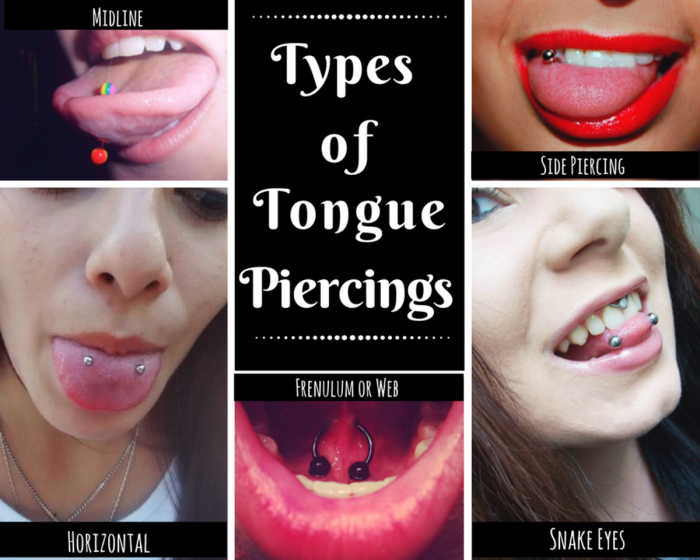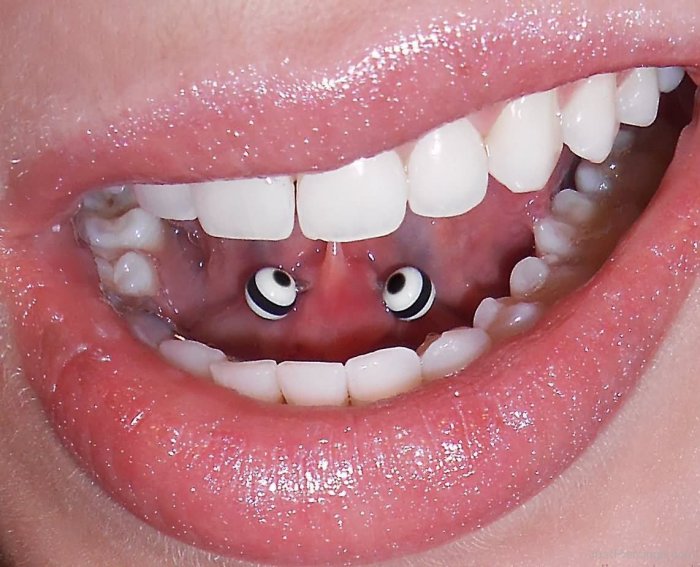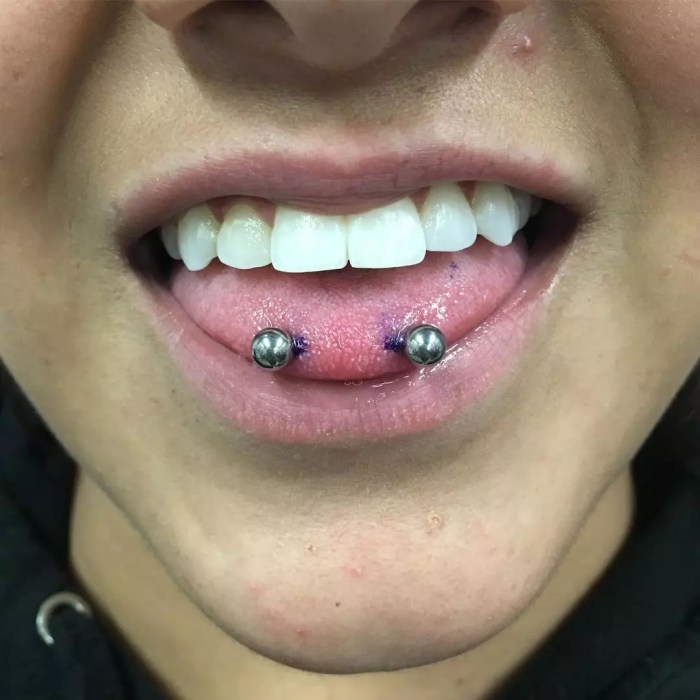Types of tongue piercings names – Tongue piercings have become increasingly popular, with various types adorning the mouths of individuals worldwide. This guide delves into the realm of tongue piercings, exploring their diverse names, piercing techniques, and cultural significance.
From the classic frenulum piercing to the intricate venom piercing, each type of tongue piercing possesses unique characteristics and implications. Understanding the anatomy of the tongue and the piercing techniques employed is crucial for ensuring a safe and successful piercing experience.
Types of Tongue Piercings

Tongue piercings are a form of body modification that involves piercing the tongue with a needle and inserting jewelry. There are several different types of tongue piercings, each with its own unique look and placement. The most common types of tongue piercings include:
Frenulum Piercing
The frenulum piercing is a piercing that is placed through the frenulum, which is the small piece of tissue that connects the tongue to the floor of the mouth. This piercing is relatively painless and heals quickly. It is a good choice for people who are new to tongue piercings.
Snake Eyes Piercing
The snake eyes piercing is a piercing that is placed on either side of the frenulum. This piercing is more painful than the frenulum piercing, but it heals just as quickly. The snake eyes piercing is a good choice for people who want a more dramatic look.
Venom Piercing
The venom piercing is a piercing that is placed through the tip of the tongue. This piercing is the most painful of all the tongue piercings, but it also heals the fastest. The venom piercing is a good choice for people who want a piercing that is both unique and edgy.
Vertical Tongue Piercing
The vertical tongue piercing is a piercing that is placed through the center of the tongue, from top to bottom. This piercing is the most difficult to get and the most painful to heal. However, it is also the most unique and dramatic of all the tongue piercings.
Tongue Piercing Anatomy

The tongue is a muscular organ located in the oral cavity. It plays a vital role in speech, mastication, and swallowing. The tongue’s anatomy is complex, consisting of various structures that influence the healing process and potential risks associated with tongue piercings.
Frenulum
The frenulum is a thin fold of tissue that connects the underside of the tongue to the floor of the mouth. It restricts the tongue’s movement and prevents it from falling back into the throat. Piercing the frenulum can cause discomfort and bleeding, as it contains a rich network of blood vessels and nerves.
Papillae
The tongue’s surface is covered in small projections called papillae. These papillae contain taste buds, which are responsible for sensing different flavors. Piercing through the papillae can damage the taste buds and impair the sense of taste.
Muscles
The tongue is composed of several muscles that allow it to move and change shape. These muscles are responsible for tongue movement during speech, swallowing, and mastication. Piercing through the muscles can affect their function and cause difficulty with these activities.
Location of Piercing
The location of the tongue piercing plays a crucial role in determining the healing process and potential risks. Piercings near the tip of the tongue tend to heal faster and have a lower risk of complications, while piercings closer to the base of the tongue can be more painful and may interfere with speech and swallowing.
Piercing Techniques

Tongue piercings can be performed using various techniques, each with its own advantages and disadvantages. The two main techniques are needle piercing and clamp piercing.
Needle Piercing
Needle piercing is the most common technique used for tongue piercings. It involves using a hollow needle to create a hole through the tongue. The needle is typically inserted from the bottom of the tongue and pushed through to the top.
This technique is relatively quick and easy to perform, and it causes less trauma to the tongue than clamp piercing.
Clamp Piercing
Clamp piercing is a less common technique that involves using a clamp to create a hole through the tongue. The clamp is placed on the tongue and squeezed together, creating a hole. This technique is more painful than needle piercing, and it can cause more trauma to the tongue.
However, it is also more precise, and it can be used to create piercings in specific locations on the tongue.
Aftercare and Healing

Aftercare for tongue piercings is crucial to prevent infection and ensure proper healing. Here are the essential steps:
Rinse with Saline Solution:Rinse your mouth with a saline solution (1/4 teaspoon salt dissolved in 8 ounces of warm water) several times a day, especially after eating or drinking. This helps remove bacteria and food particles that can cause infection.
Avoid Certain Foods:Avoid spicy, acidic, or sticky foods that can irritate the piercing. Stick to soft, bland foods like yogurt, oatmeal, or soup for the first few days.
Avoid Alcohol and Smoking:Alcohol and smoking can slow down healing and increase the risk of infection.
See Your Piercer:If you experience any signs of infection, such as redness, swelling, or discharge, see your piercer immediately.
Potential Risks and Complications
Tongue piercings carry some potential risks and complications, including:
- Infection:Bacterial infection is the most common complication of tongue piercings. It can cause pain, swelling, and discharge.
- Swelling:Tongue piercings can cause significant swelling, especially in the first few days. This can make it difficult to speak or eat.
- Bleeding:Tongue piercings can cause bleeding, especially when they are first done or if they are irritated.
- Nerve Damage:In rare cases, tongue piercings can damage the nerves in the tongue, leading to numbness or tingling.
- Chipped or Broken Teeth:Tongue piercings can come into contact with teeth, potentially chipping or breaking them.
To minimize these risks, it is important to follow the aftercare instructions carefully and see your piercer if you experience any problems.
Jewelry Options

Tongue piercings offer a wide range of jewelry options to suit individual tastes and preferences. The choice of jewelry is crucial for comfort, aesthetics, and healing.
The most common types of jewelry used for tongue piercings include:
Barbells
- Straight barbells: Consist of a straight shaft with a ball on each end.
- Curved barbells: Feature a curved shaft with a ball on each end.
- Horseshoe barbells: Resemble a horseshoe shape with a ball on each end.
Studs
Consist of a small, flat disc with a post that is inserted through the piercing.
Rings
Circular or horseshoe-shaped jewelry that is inserted through the piercing and closed with a ball or bead.
When choosing tongue piercing jewelry, several factors should be considered:
- Material:Surgical-grade stainless steel, titanium, and gold are common materials used for tongue piercings.
- Size:The length and thickness of the jewelry should be appropriate for the size of the tongue and the placement of the piercing.
- Style:The choice of jewelry style depends on personal preference and the desired aesthetic.
Tongue Piercing Culture: Types Of Tongue Piercings Names
Tongue piercings have a rich and diverse cultural history, with varying significance across different societies. In some cultures, they hold deep symbolic meanings, while in others, they are primarily seen as a form of personal expression.
Symbolism and Meanings
Tongue piercings have been associated with various meanings and symbols throughout history. In ancient cultures, they were often used as a rite of passage or to mark important life events. In some indigenous communities, tongue piercings symbolized strength, courage, and wisdom.
In other cultures, they have been associated with rebellion, nonconformity, and sexual freedom.
Over time, the meanings associated with tongue piercings have evolved. In contemporary society, they are often seen as a form of self-expression and individuality. They can be used to convey personal style, subcultural affiliation, or simply a desire to stand out from the crowd.
Cultural Variations, Types of tongue piercings names
The cultural significance of tongue piercings varies widely across different societies. In some cultures, such as the United States and Western Europe, they are relatively common and accepted. In other cultures, they may be seen as taboo or disrespectful. In some conservative or religious communities, tongue piercings may be associated with negative stereotypes or discrimination.
It is important to be aware of the cultural context when considering a tongue piercing. In some situations, it may be necessary to remove the piercing or avoid displaying it publicly in order to avoid offense or conflict.
Question Bank
What is the most common type of tongue piercing?
The frenulum piercing, located at the midline of the tongue, is the most prevalent type.
How long does a tongue piercing take to heal?
Tongue piercings typically take 4-8 weeks to heal completely.
Can tongue piercings damage my teeth?
Properly placed tongue piercings should not harm teeth if appropriate jewelry is worn and proper oral hygiene is maintained.